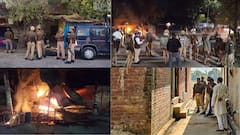Murder Near Kamakhya: The Shocking Case Of Assam 'Human Sacrifice', A Saga Of Blind Faith And Deception
After four years, police claim to have cracked Assam's 2019 'human sacrifice' case, with the arrest of five accused. But the question remains: How far can blind faith go?

Around 25 lakh people visit Assam's Kamakhya temple during the Ambubachi Mela every year. Sixty-four-year-old Santi Shaw from West Bengal was one of them in 2019. She had come to Kamakhya with a sadhu and two other women in early June of that year. She never returned home, and the family never heard from her again.
Cut to June 19, 2019: A headless body, of a woman, wrapped in a blanket was found on the staircase of a temple on the Kamakhya premises. Local media flashed the news and the public believed this was a case of human sacrifice. With no detail available and the victim's identity remaining unknown, the police downplayed the human sacrifice angle at that time, and so did the temple authorities. Some context here — back in 2013-2014, the severed head of a man was recovered near a road leading to the Kamakhya temple. The local media had played it up as a human sacrifice case. However, it later came to light that the man had been murdered over a financial dispute and his head was disposed of at near the temple to make it look like a human sacrifice case.
In the present case, the Jalukbari police registered a suo motu case and a hunt was launched to recover the severed head of the victim. The head could never be found and the investigation slowed down due to lack of clues and direction, until July when a man identified the woman as his mother.
Suresh Shaw of Bengal's Hoogly got to know through news reports that the headless body of a woman had been recovered at the Kamakhya temple. He identified the body by her clothes and the tattoo on her body. At this point, the case saw some hope. But the police still could not gather any information about the accused involved, until a special team was constituted and one clue led to the other.
Click here to know how police cracked the case after four years
Identified In The Day, Killed At Night
The prime accused in the case is Pradeep Pathak, a resident of Mathura in Uttar Pradesh. He allegedly 'sponsored' a special puja in the name of his brother who had become a Naga Sadhu and died on June 18, 2008 — the day Santi Shaw was killed in 2019. He plotted the murder with his accomplice, another sadhu who is yet to be nabbed. According to the police, the duo had identified the victim and planned the murder along with the sadhu who came with Santi Shaw. They purchased a 'dao' — the weapon which was used to behead Santi — earlier in the day.
The Fateful Night
The special team of Assam Police had got hold of one Kailash Barman of Cooch Behar, which led them to 'Baba' Mata Prasad Pandey. It was Pandey who spilled the beans about the murder at Kamakhya, according to the police. Pandey said a total of 12 people were involved in the crime, and each of them was given Rs 10,000 by Pathak.
He told the police that on the intervening night of June 18 and 19, the group held three pujas. The first puja was held at Bhootnath — a cremation ground in the foothills of Neelachal Hills where the Kamakhya temple is located. Tantriks and sadhus are known to stay in the area and perform pujas. When this puja was over at midnight on June 18, the group went to the cremation ground at Kamakya temple for another puja. The last puja was held at the Joy Durga Mandir.
By this time all the accused were drunk, and they had made Santi also consume alcohol. In fact, they made her drink more, perhaps to make their job easier, the police said. By this time, Santi, who was wearing a saffron saree during the pujas, had been made to change into a white saree. A heavily drunk Santi was made to lie down on a blanket, and some of the accused held her hands and legs and one of them beheaded her, Pandey reportedly told the police.
A Murder By A Distorted Mind, Says Kamakhya
Speaking to ABP Live, Bhupesh Sharma, Secretary, Kamakhya Temple, said: "First, I want to say that the word sacrifice is not applicable to this case at all. This is a murder committed by a person with demented psychology. At Kamakhya, we worship the Goddess and we worship women of all ages. Even in our 'shastras', women were never sacrificed. Such people should not call themselves 'tantriks' at all when they don't even know what our shastras say. Nobody should attribute the word 'sacrifice' to this case, it's a murder."
He added: "Human sacrifice is a thing of the past when people or not educated or aware enough. At Kamakhya, which worships the goddess Kamakhya as a mother, no woman can be treated like that — this woman was murdered."
Bhootnath: Cremation Ground That Wears A Dreaded Look At Night
A cremation ground thronged by many during the day becomes a dreaded place at night. A place known to be inhabited by aghoris and tantriks, it is usually avoided by most people at night. It's a place where Naga sadhus reportedly take shelter to practise black magic and perform certain pujas discreetly. After the 2019 case made headlines, the police chased them away from the area and pushed them into hiding.
Kamakhya authorities, however, said the area has been developed now and is no longer unsafe for people, though local media reports say otherwise.
The discreet nature of this place and its aura could have been a reason why the accused chose this place to murder Santi Shaw.
Violence Can't Remove Violence
As the case created a stir across the nation and headlines flashed even on international dailies, former Assam DGP Kuladhar Saikia told ABP Live that "violence cannot remove violence".
Asked about the particular case, the cop known for his role in community development and community policing and also his efforts towards eradication of social evils such as witchcraft said: "It's a cold-blooded murder, and it does not happen just in Assam. It's important to understand the psychology behind such murder and get inside the head of the criminal to be able to prevent such cases from happening in the future."
Saikia, with his pet project Prahari had targeted such issues in villages and succeeded in making several villages free of such practices with community participation, awareness, and installing medical camps. His work has also been documented in a three-part case study and is available in Harvard Business Review titled: Being a Change Agent.
Understanding The Mind Of The Criminal
As former Assam DGP Saikia pointed out, regular interrogation cannot be conducted in such crimes as in the head of the criminal they are not wrong. He said "interrogation in such cases must be done in bits and pieces" to understand the mind of the criminal, and that the "legal machinery should be tuned to the need of the time".
While Pandey and Pathak were arrested from Madhya Pradesh and Uttar Pradesh, respectively, the three others — Suresh Paswan, Kanu Acharjee alias Kanu Tantrik and Bhaiyaram Maoreya alias Raju Baba — were picked up from Bhootnath.
The police have also recovered the clothes and railway tickets of the victim woman and seized the mobile phones of all five accused. A hunt is on to arrest the remaining accused in the case.





































